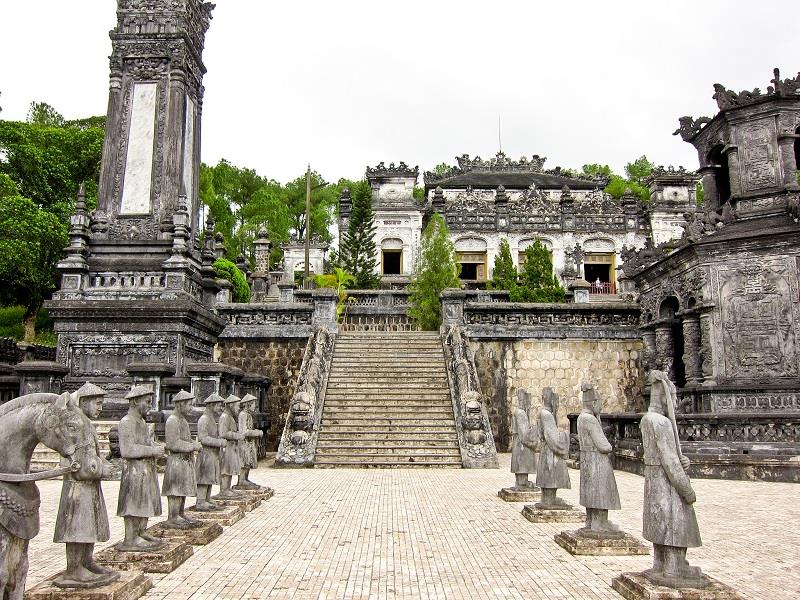Thua Thien - Hue is home to numerous tombs of Nguyen Dynasty's Kings which are recognized as world heritages by UNESCO. Contributing to the common art treasure of humanity is the system of tombs and mausoleums with abundant styles expressing Emperors' characteristics. Currently, compared to other mysterious tombs in Vietnam, Tomb of Khai Dinh has been relatively intact and owned a unique architecture. Emperor Khai Dinh decided to locate his tomb imperial at the foot of the mountain Chau Chu, 9 kilometers south of Hue city. In comparison with the rest of imperial tombs, this imperial tomb is small in extent, little more than 5600 square meters; however, its construction, decoration and details are very elaborate.

Khai Dinh became the Emperor of Vietnam in 1916 at the age of 31. Right after taking the throne, he built many palaces, buildings, and royal tombs for himself and his own imperial clan, such as Kien Trung Palace, An Dinh Palace, Trang An Gate, Hien Nhon Gate, Chuong Duc Gate, and especially Ung tomb (former Khai Dinh Tomb). Compared to tombs of previous predecessor Emperors, namely Gia Long Tomb, Minh Mang Tomb, Tu Duc Tomb, Dong Khanh Tomb, Duc Duc Tomb, Khai Dinh Tomb covers an area of much more modest, with dimension of 117m x 48.5m whereas extremely elaborate and time consuming to complete the tomb. In detail, it took 11 year to finish the tomb.
Unlike Tomb of Tu Duc bringing the atmosphere close to nature, as a watercolor painting, Khai Dinh Tomb when newly accomplished was compared as a colorful, magnificent and extremely showy cage. Yet, fine art and painting studies today must take their hat off before the architectural sculpture quintessence reaching sophistication in lines, and harmony in layout to build a magnificent tomb. This turns the tomb into a masterpiece stretching Vietnam history.

The location of Khai Dinh Tomb was carefully calculated. Accordingly, the position of hilly mountains, streams around the tomb were relative with the geographical feng shui elements, creating majestic and breathtaking natural scenery. Architecture of the Tomb of Khai Dinh was extremely strange, far different from structures of previous predecessor Emperors' tombs. Talking about feng shui, this area was an ideal land to build the tomb. Paricularly, Thien Dinh Palace was in the highest position and the main architecture of the tomb. It consisted of five consecutive parts tightly incorporating together. The 2-side rooms were for guard soldiers. In front was Khai Thanh Hall retaining the altars and portraits of Khai Dinh Emperor. In the middle was the burial area with the emperor statue on the top and deep down below was the grave of Khai Dinh Emperor. In the rear was the altar of Khai Dinh Emperor. The tomb remained a high slope. From the street to the main palace was a floating rectangular blocks up to 127 doorsteps. In particular, Khai Dinh was very fond of foreign elements. He specially enjoyed the beauty of modern Western culture. His tomb's architecture thus owns a perfect combination of European and Asian culture, between classic and modern features. Tomb of Khai Dinh held a west - east architecture, a wonderful harmony of many architectural features of Hinduism, Buddhism, Roman, and Gothic...

In populations of tombs, Tomb of Khai Dinh was built with cement and steel, meanwhile the others were implemented with mortar and masonry. There were two houses for civil and military mandarins; yet, the king had died when the building was on the way to be finished. The tomb was completed by Emperor Bao Dai, Khai Dinh's successor in 1931. This was the oldest lasting building and also the last royal tomb constructed in Nguyen Dynasty.
The system of Khai Dinh Tomb completed 83 years ago, so far it has been still relatively intact. The most artistic values and excellent features of the tomb are Thien Dinh Palace, the burial place of King Khai Dinh's corpse. The primary responsibility to create the perfect work of art in the Thien Dinh Palace was Pham Van Tanh artist, author of 3 murals “9 dragons hidden in cloud), the biggest murals in Vietnam. It was decorated the ceiling of three halls in Thien Dinh Palace.

Tomb of Khai Dinh is the pinnacle of visual art on porcelain and glass. It is actually a valuable work of art and architecture. Tourists once participating in Hue tourism in general and Khai Dinh tomb in particular will actually get unforgettable memories.
